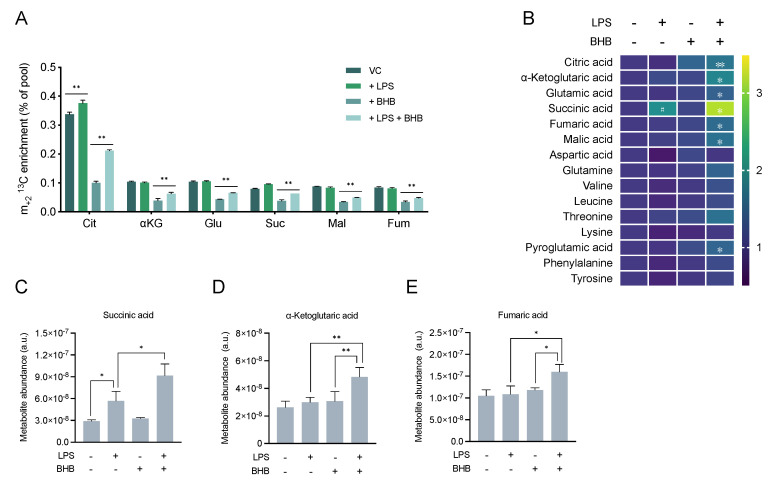Figure 3.
TCA cycle metabolism in response to lipopolysaccharide (LPS) and β-hydroxybutyrate (BHB) in BV2 cells. Experiment was performed as described in Figure 2. (A) m+2 13C enrichment of TCA cycle intermediates (Cit, citrate; αKG, α-ketoglutarate; Glu, glutamate; Suc, succinate; Mal, malate; Fum, fumarate). Bars represent mean ± SD of n = 3 biological replicates. (B) Metabolite levels normalised to untreated cells and expressed as fold-change as per colour-coded scale. Each data point represents mean of n = 3 biological replicates. Statistical significance was assessed by two-way ANOVA (succinate: LPS p < 0.0001, BHB p = 0.011, LPS × BHB p = 0.029; α-ketoglutarate, fumarate, malate, aspartate: LPS p < 0.05; citrate, α-ketoglutarate, fumarate, malate, aspartate, and pyroglutamate: BHB p < 0.05) followed by Tukey’s test (untreated vs. +LPS, untreated vs. +BHB, -BHB +LPS vs. +BHB +LPS). A complementary statistical analysis using Fisher’s LSD test followed by false discovery rate (FDR) correction to account for multiple comparisons both across treatment class and metabolite class can be found in Supplementary Table S3. (C–E) Bar chart representation of the abundance of metabolites with known immunomodulatory activity. Bars represent mean ± SD of n = 3 biological replicates. Statistical significance is denoted as * p < 0.05, and ** p < 0.01, with exception of Figure 3B, where statistical significance between untreated and single treatments (untreated vs. +LPS, untreated vs. +BHB) is denoted as # p < 0.05, and statistical significance between single treatment with LPS and double treatment (−BHB + LPS vs. +BHB +LPS) is denoted as * p < 0.05 and ** p < 0.01.

